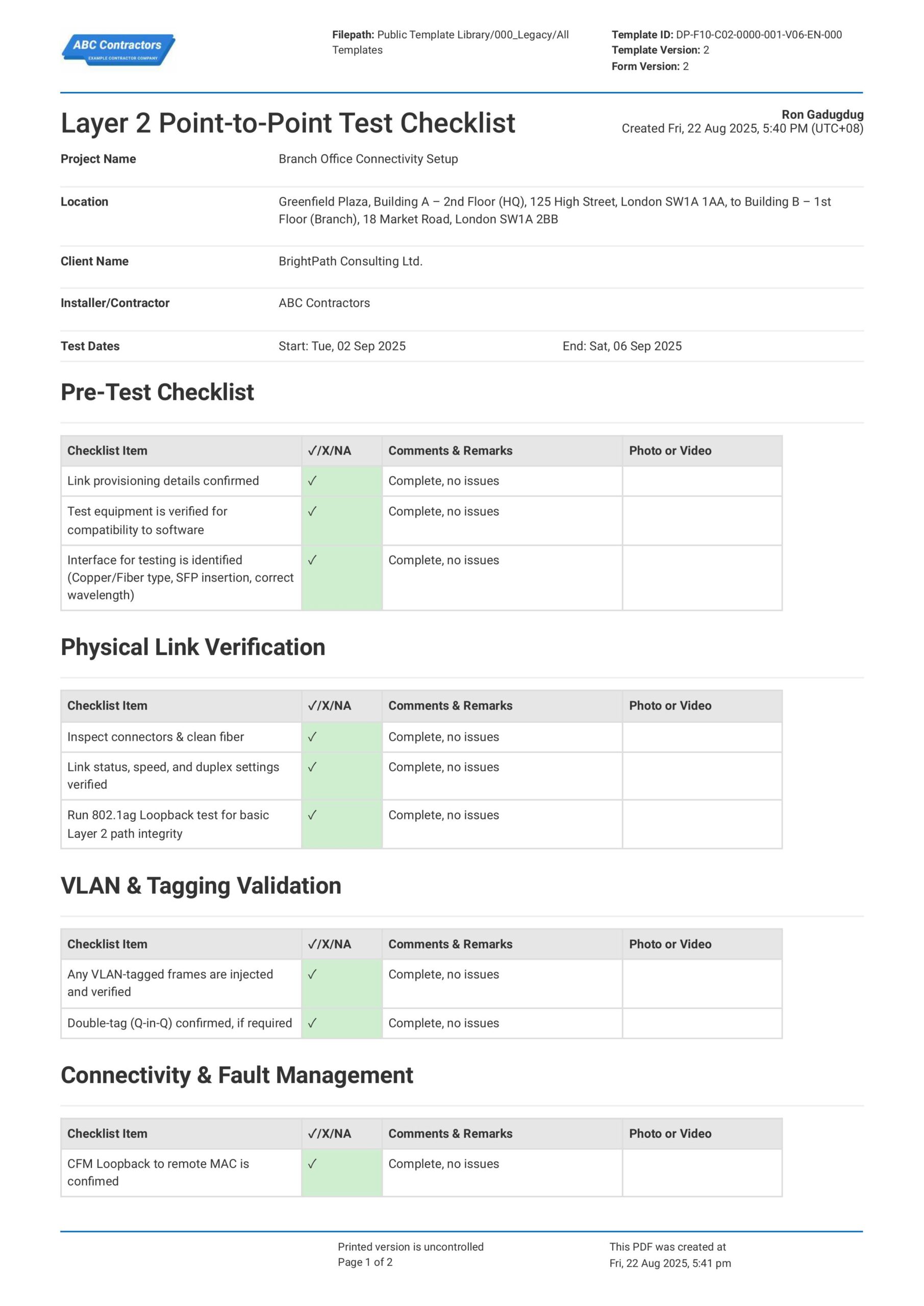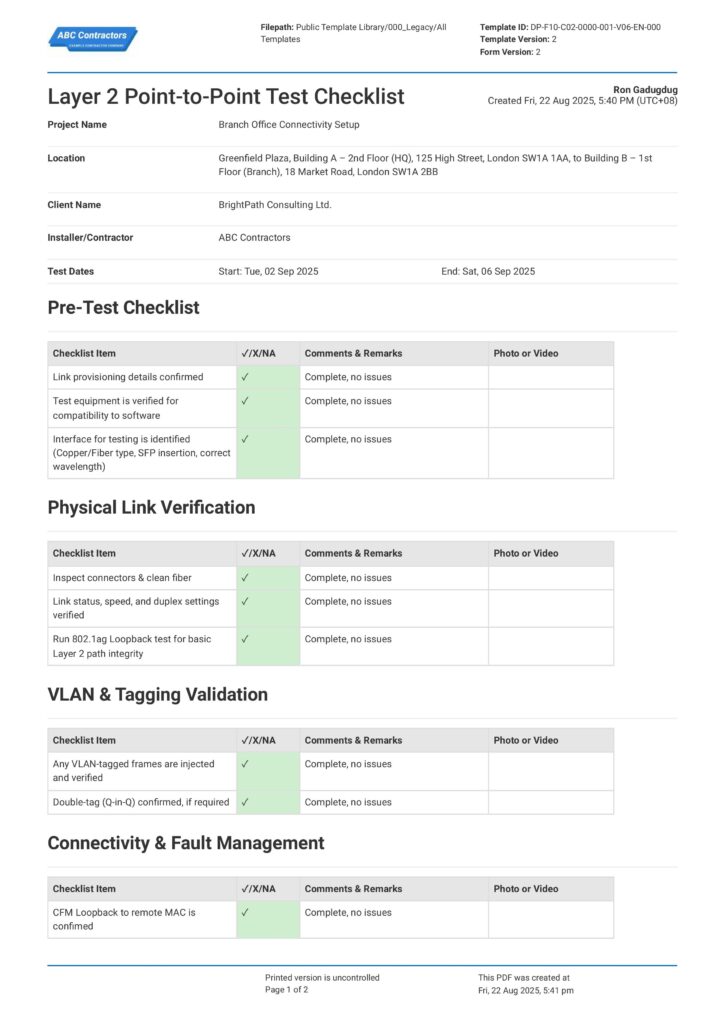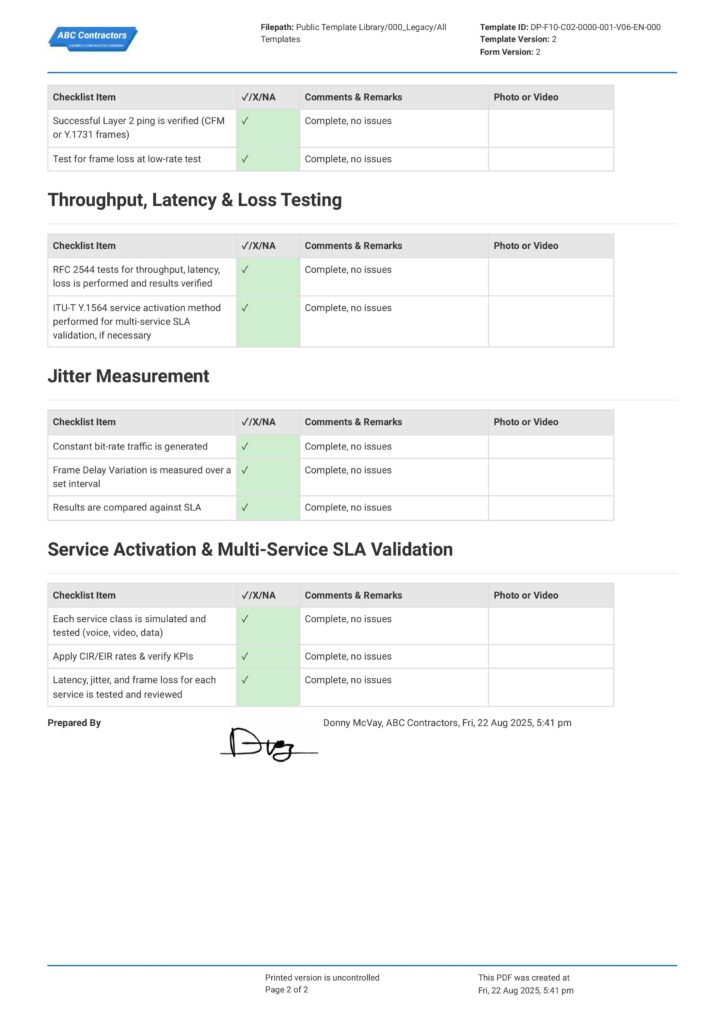Article Page – What is Point-To-Point Testing?
What is Point-To-Point Testing?
A point-to-point network is a simple, yet often critical, system that services many of today’s important industries. Here we discuss how technicians and engineers test these systems using industry best practices using free and practical and digital resources, ensuring reliability, compliance, and efficiency.

Table of Contents
Article Summary
- Using a Point-to-Point (P2P) testing verifies that the direct data connection between two points or nodes is safe, reliable, and fast.
- To perform a good P2P test, you will need to define the scope and parameters of the test, identify necessary materials and instruments, execute the test itself, and record & investigate results.
- A proper P2P test helps technicians and engineers plan out and perform tests more efficiently, ensuring quality work and compliance to standards.
Why is it Important to Test Point-to-Point Systems?
It is important to test Point-to-Point systems, as they serve as the direct means of communication and data transfer between two points or devices. Point-to-Point systems are valued for their simplicity, reliability, and speed. Several industries and services make use of systems like these for connectivity as simple as your household Wi-Fi, to as critical as the direct air-traffic control radio link between aircraft and ground control towers.
The very first phone call made by Alexander Graham Bell to his assistant, Thomas Watson, was the very first point-to-point connection link made with his words, “Mr. Watson, come here; I want to see you”. This call laid the foundations of modern day telecommunications.
Needless to say, it is important to test point-to-point systems to ensure quality performance, no matter the level of application. Testing these systems guarantee the reliability, performance, security, and compliance of the network to industry standards and regulations.
How to Format a Proper Point-to-Point Test
There are several tests that technicians perform on point-to-point systems, depending on the network structure and the existing equipment. In order to perform an adequate test for point-to-point connections, you will need to be aware of what you’re testing for, the appropriate tests to conduct, and any relevant industry regulations.
Preparing a testing plan can get tricky, especially when dealing with more complex networks and requirements. Most engineers and industry professionals usually use documents and forms to list down the testing phases and tasks, which ensure they perform all the necessary tests and stay compliant to industry standards and regulations. To give you a better picture of what this could look like, we’ve built a Point-to-Point Test form you can check out for free in the preview below.

Use this Point-to-Point Test Checklist for free
How to Conduct a Point-to-Point Test
Point-to-point test procedures can differ depending on the network infrastructure and other physical constraints. However, there are some practical steps for every test that you should perform when you conduct your testing:
Define the Scope of the Test - What is Point-to-Point Testing?
First, you will need to identify the points that you will be testing. This can be between any two devices (such as routers, radio units, sensors, electronic devices, etc). Talk with your client to see if they have any requirements or SLAs on important parameters like reliability, up-time, latency, or error handling. This will be the parameters you will need to check for during test result analysis.
Prepare Test Materials and Equipment
Next, you will need to identify the physical points that you will be testing. Are they installed correctly? Are there any signs of physical damage? If you are testing cables or any other physical equipment, make sure they are disconnected or isolated from any live power or other active equipment.
You will also need to identify the correct testing instruments for testing and make sure they are calibrated correctly for those tests. This may include multitesters, continuity testers, and fiber-optic light sensors, packet generators, Bit Error Rate Testers, or performance testing software, depending on what you are testing.
Performance of Test Procedures
Then you will need to execute the actual tests on the system. This also includes pre-test inspections and verifications. You will need to run through all the tests, record results, label the tested points (if applicable), note recommendations or any corrective tasks, and take photos or videos of the testing.
Result Analysis and Documentation
Finally, you will need to compile your test results for analysis and verification against the agreed-upon testing parameters. Most companies and professionals compile these into final reports for easy analysis and archiving. Then you will need to execute the actual tests on the system. This also includes pre-test inspections and verifications. You will need to run through all the tests, record results, label the tested points (if applicable), note recommendations or any corrective tasks, and take photos or videos of the testing.
What is Point-to-Point Testing: Electrical & Network Systems
Point-to-Point (P2P) testing is a procedure done to verify that the connectivity between two points or devices, whether in an electrical system (wirings, circuits) or a network system (data communication links), is correctly installed and functions as intended. In electrical systems, it ensures that newly installed wirings are correctly terminated, without defects like short circuits or miswiring, and are insulated, grounded, and set to the correct polarity. In network systems, P2P tests are done to verify the integrity, reliability, and speed of a direct data communication link between two points (e.g. servers, routers, radios).
Streamlining Point-to-Point Testing Procedures
There are several tests that you will need to perform on your P2P systems. With all the test procedures, tasks, data results and recording, and analysis, tracking these tests can get hectic. Not to mention the mountain of paper your team will have to deal with in the end.
To get you better set to tackle testing procedures, Test Record App is the perfect tool. Teams can conveniently take workflows to the digital space and streamline them through by on-site documenting, taking notes using phones and tablet, attaching photos with geotags and markups, reliable reports, and even sign-offs all in one place - no spreadsheets needed.
Summary of Point-to-Point Testing
Point-to-Point testing is a procedural verification of the reliability, speed, and safety of a direct connection between two nodes or points within a network. This connection can be between routers, servers, electronic devices, radios, or any combination of these equipment. In order to conduct a good test, you will need to set acceptance parameters, prepare materials and instruments, execute the test, and record and investigate the results. And similarly, in order to efficiently conduct reliable tests and proper documentation, it's key to incorporate digital tools in the workflow.
Frequently Asked Questions
Is Point-to-point (P2P) testing required by any regulatory bodies?
Althrough there is no specific international regulation that requires installers or contractors to perform P2P testing specifically, the regulations that are present usually focus more on the safety aspect of network systems and testing. For example, the UK Data Protection Act 2018 (DPA 2018) and the ISO/IEC 27001 both require regular testing and evaluation of network security. Companies still need to ensure that network security is reliable and efficient across all projects and sites.
How can technology improve P2P testing processes?
Many companies now look to streamlining their testing tasks and procedures. Online tools like pre-formatted templates, forms, checklists, and even online tests help site and engineering teams perform documentation and recording tasks more efficiently, so they can focus on the real site work.
Does Sitemate offer templates to help with P2P testing?
Yes, Sitemate offers P2P test, along with other templates like Network Commissioning Test Plan, Cable Continuity test, and Cable Installation form to help you and your team perform quality work more efficiently. .
Related resources

Network Commissioning Test Plan
Create a streamlined, detailed and thorough plan using a digital tool like this Network Commissioning Test Plan

Cable Continuity Test Checklist
Verify that electrical and data cables have continuous and unbroken path directly on site using your mobile device or tablet.

Structured Cabling Installation Checklist
Use this guide to ensure structured cabling systems are properly installed and safely, compliant with industry standards.

